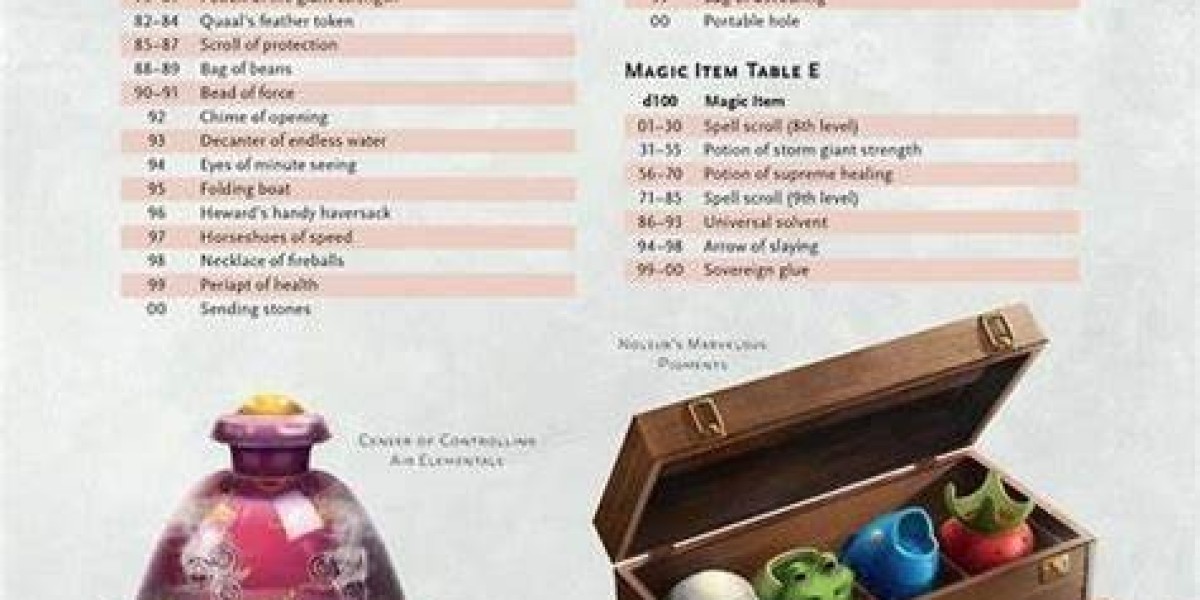In Dungeons & Dragons 5th Edition (D&D 5e), magic items play a critical role in both the narrative and mechanical aspects of gameplay. These items can range from simple trinkets with minor magical effects to powerful artifacts that change the course of a campaign. Magic items provide players with unique abilities, buffs, or spells that can turn the tide of battle or open up new options for problem-solving.
Let’s delve into various categories of identify magic items 5e , explore how they function, and consider some of the most iconic items players might encounter.
Categories of Magic Items
Magic items in D&D 5e are grouped into several categories, each providing distinct types of benefits:
- Armor
- Weapons
- Potions
- Rings
- Rods, Staves, and Wands
- Scrolls
- Wondrous Items
Each category has unique mechanics, from boosting combat capabilities to granting players new magical abilities.
1. Armor
Magic armor in D&D 5e not only enhances a character’s defense but often grants additional perks. Armor can have static bonuses to Armor Class (AC) or provide special resistances and abilities. Some notable magical armors include:
Armor of Invulnerability: A rare plate armor that grants resistance to non-magical damage. Once per day, it can be activated to make the wearer immune to all non-magical damage for 10 minutes, providing significant protection.
Mithral Armor: This light but durable armor, usually made from a rare metal, doesn’t impose disadvantage on Stealth checks, making it perfect for stealthy characters who still want solid protection.
Dwarven Plate: A rare magical plate that increases your AC and can even reduce the impact of being pushed or shoved in combat.
Magical shields also fall under this category, such as the Sentinel Shield, which provides advantage on initiative rolls and Perception checks.
2. Weapons
Magical weapons are a staple of fantasy, and in D&D, they are highly sought after for their ability to bypass resistances or immunities. Magical weapons typically have bonuses to attack and damage rolls, but some come with unique properties. Some of the most famous include:
Sword of Sharpness: A weapon with a keen edge that deals extra slashing damage and can potentially lop off limbs on a critical hit.
Vorpal Sword: Another sharp weapon, but with a deadlier effect. On a natural 20, this weapon decapitates its target unless it’s immune to decapitation.
Flame Tongue: A sword imbued with fiery magic that, when commanded, bursts into flame, dealing extra fire damage on each hit.
Certain magical weapons, like the Sun Blade, are specialized, dealing extra damage to specific creature types like undead.
3. Potions
Potions are consumable items that provide short-term magical effects. While they can’t be reused like other magic items, potions are valuable due to their versatility and instant effects. Some notable potions include:
Potion of Healing: One of the most common potions, available in several strengths (Regular, Greater, Superior, and Supreme). It’s a staple for any adventurer, restoring hit points when consumed.
Potion of Invisibility: This grants the drinker invisibility for one hour or until they take an aggressive action, like attacking or casting a spell.
Potion of Flying: When consumed, this potion allows the user to fly at a speed of 60 feet for one hour, a tremendous advantage in combat or exploration.
Potion of Heroism: Grants 10 temporary hit points for 1 hour and provides the user with the effects of the bless spell for the duration.
Potions tend to be one-use items, but their effects can often turn the tide in critical situations.
4. Rings
Magical rings are powerful items that grant their wearer passive benefits or activatable abilities. Here are a few well-known examples:
Ring of Protection: Grants a +1 bonus to AC and saving throws, making it one of the most universally useful items in the game.
Ring of Spell Storing: This allows a caster to store spells inside the ring, enabling them to cast the stored spell later without using a spell slot. The ring can hold up to 5 levels worth of spells at a time, providing flexibility in combat or utility situations.
Ring of Invisibility: This ring allows the wearer to turn invisible at will. The invisibility ends if the wearer attacks or casts a spell but can be reactivated instantly, making it useful for stealth and evasion.
Ring of Feather Falling: A lifesaver in precarious situations, this ring automatically casts the feather fall spell on the wearer when they fall, slowing their descent and preventing fall damage.
5. Rods, Staves, and Wands
Rods, staves, and wands are magical implements often associated with spellcasters. These items can either enhance spellcasting or grant new spells entirely. Some examples include:
Wand of Fireballs: A wand that can be used to cast fireball, a high-damage area-of-effect spell, multiple times per day. Extremely powerful in the hands of an offensive spellcaster.
Staff of Power: This is one of the most versatile and potent magic items for a caster, granting bonuses to attack rolls, AC, and saving throws, while also allowing the wielder to cast a variety of powerful spells like lightning bolt or cone of cold.
Rod of the Pact Keeper: This rod provides warlocks with bonuses to their spell attack rolls and DCs and can even allow them to recover a spell slot once per day.
Wands, rods, and staves are often limited by the number of charges they can expend in a day, but they recharge regularly and provide strong magical effects.
6. Scrolls
Scrolls are single-use items that allow any character to cast the spell written on them. Spell scrolls can contain any spell from the D&D spell list, making them incredibly versatile. Some key points about scrolls:
Scroll of Fireball: Any character can use this scroll to cast fireball, even if they don’t know the spell. This allows martial characters to unleash a devastating magical attack.
Scroll of Teleport: A useful tool for instant travel over long distances.
Scroll of Resurrection: Allows a character to bring a deceased ally back to life without needing the spell prepared or the appropriate spell slot.
Scrolls provide powerful, one-time use spells that can often circumvent the limitations of a party’s current resources.
7. Wondrous Items
Wondrous items are a catch-all category for magic items that don’t fit neatly into other groups. They range widely in power and use, from common utility items to legendary artifacts. Some notable examples include:
Bag of Holding: A common but incredibly useful item, this magical bag can hold up to 500 pounds of items without changing its weight, making it a staple for adventurers who collect treasure and equipment.
Cloak of Invisibility: This cloak allows the wearer to become invisible at will, similar to the Ring of Invisibility but more versatile.
Deck of Many Things: A dangerous and unpredictable item, this deck contains cards that can have both beneficial and harmful effects when drawn, from granting immense wealth to banishing the user to another plane of existence.
Winged Boots: These boots allow the wearer to fly for up to 4 hours per day, making them invaluable for both combat and exploration.
Amulet of Health: This amulet sets the wearer’s Constitution score to 19, providing a massive boost to hit points and Constitution-based saving throws.
Wondrous items often provide unique, game-changing abilities that can significantly affect the party's success.
Rarity and Attunement
In D&D 5e, magic items are classified by rarity: Common, Uncommon, Rare, Very Rare, and Legendary. The more rare an item is, the more powerful or specialized its effect tends to be. Legendary items, for example, might have unique lore tied to them and be central to a campaign’s plot.
Many powerful magic items require attunement, meaning a character can only benefit from a limited number of these items at a time. Typically, a character can be attuned to a maximum of three items. This balancing mechanic prevents players from stacking too many powerful effects from magic items and ensures that each magic item is carefully considered.
Conclusion
Magic items in D&D 5e are integral to the experience, adding depth to character progression and strategy. From the simplest potion to the most legendary weapon, each magic item brings a unique flavor to the game, offering both mechanical advantages and storytelling opportunities. Whether enhancing combat prowess, enabling new forms of exploration, or providing vital buffs, magic items are a source of excitement and creativity for both players and Dungeon Masters alike. Understanding how to use them effectively can make all the difference between success and failure in a campaign.








